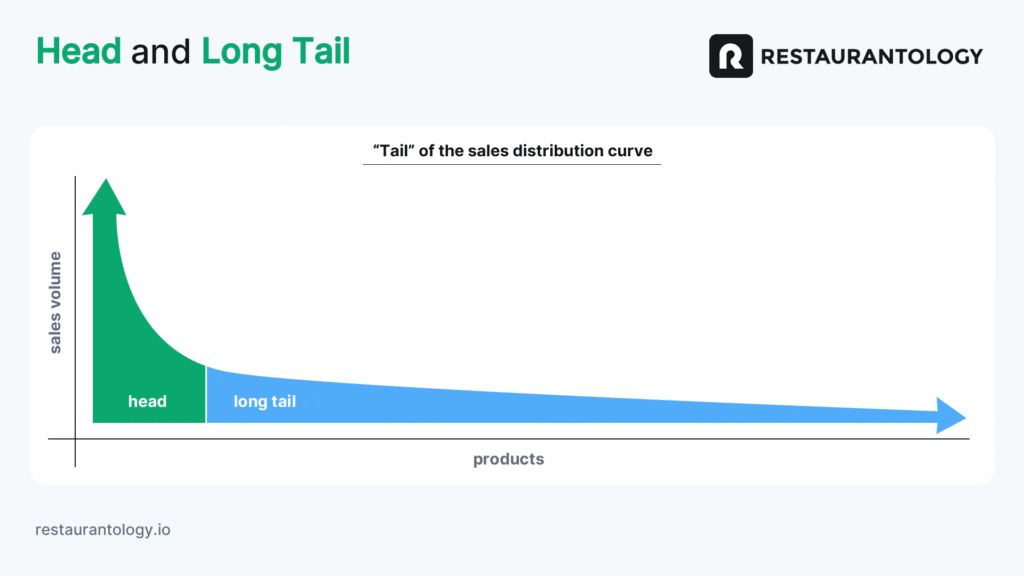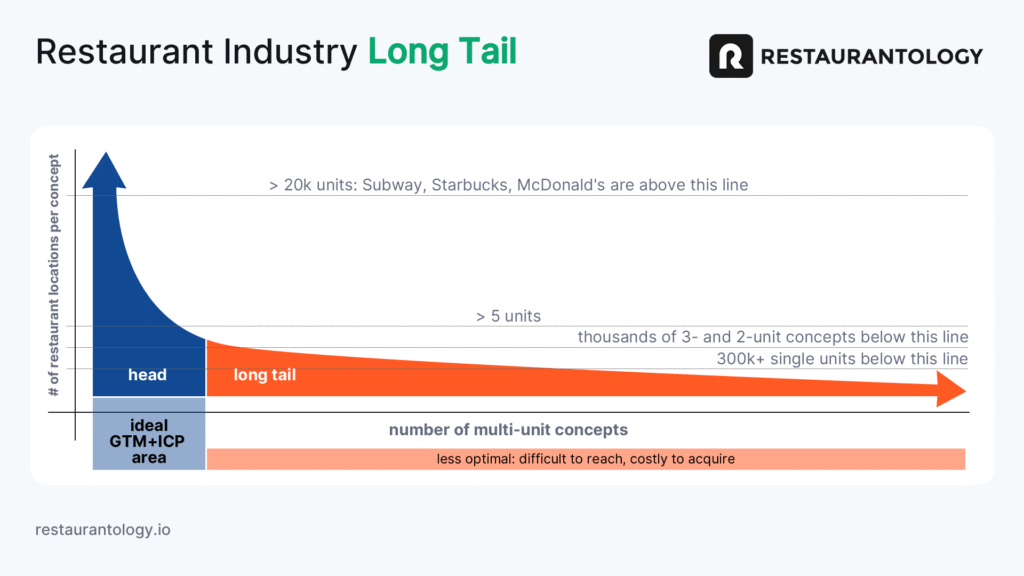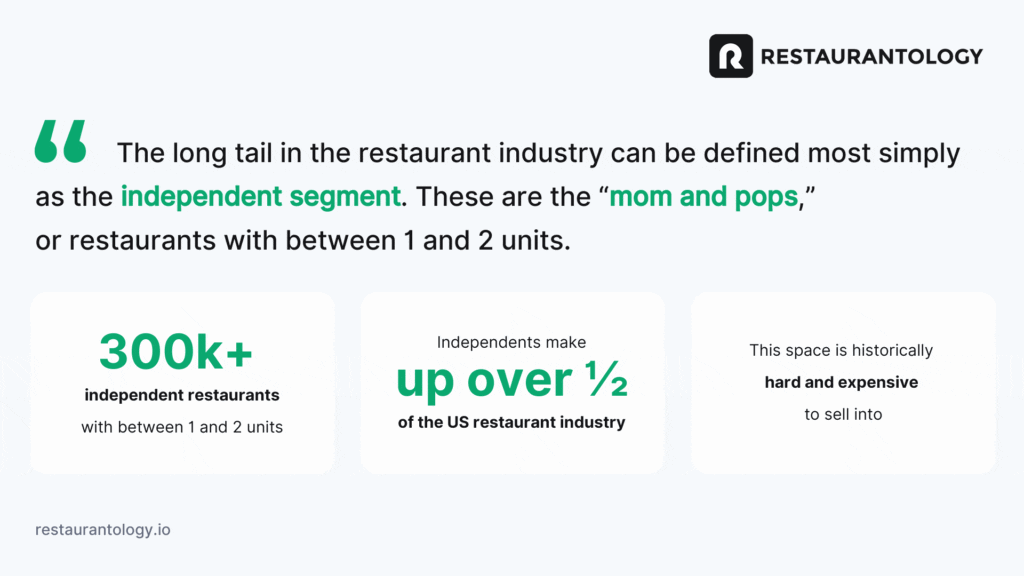The restaurant industry “long tail”

Ciao! Welcome to the first Restaurantology Office Hours. This will be our time to discuss, debate, and dissect topics around restaurant market intelligence, go-to-market strategy, RevOps, data governance and activation … and, really, anything else that will help you and your teams operationalize your systems and teams with better market intelligence.
Let’s dig in.
Background
Long tail is a term we use pretty regularly at Restaurantology.
If you know me or have heard me talk about the complexities of selling into the restaurant industry, you know how passionate and persistent I am about the benefits of agreeing on—and ultimately using—the same glossary of terms to describe and discuss the restaurant industry.
For this office hours, I’m going to spend more time than usual defining the Long Tail inside and outside of the restaurant industry.
Defining the long tail
The term “long tail” was coined by Chris Anderson in an article (which was originally published in WIRED in 2014 and was later turned into a book titled The Long Tail: Why the Future of Business is Selling Less is More). He started with a simple question: What happens when traditional supply and demand disappears and everything becomes available to everyone? When faced with unlimited choice of anything in the age of the Internet, consumer purchasing behavior will inevitably change. And when consumers change, so too does the way we think about our markets and how to get to them.
Chris observed that companies like Netflix, Amazon, and iTunes could sell obscure products to a global audience and that, over time, products in low demand or with low sales volume can collectively make up market share at a success rate that rivals or exceeds the relatively few current best sellers.
This is the “tail” of the sales distribution curve. While these customers may not be a significant source of revenue in the short-term, they can [1] represent a large enough distribution channel to earn a company significant market share and [2] become a key source of future business for your company through upselling and cross-selling efforts of additional products.

The restaurant industry long tail
At the most basic level, the long tail is the independent segment of the restaurant industry. These are the “mom and pops,” or restaurants with between 1 and 2 units.
This segment makes up over half of the US restaurant industry–around 300k locations based on my estimates. A majority that can be broken down into even more niche market segments.


300k is a lot of whitespace. You should see how board members and executives react when they see that number. Revenue adds up quickly.
But this is a false positive. There are a few really crucial points we need to make here.
The independent space is massive. But for almost every company out there selling to restaurants, single units are unobtainable. Why? Because—and trust me on this because I’ve tried—it’s historically hard and expensive to sell into.
Independent restaurants have a high failure rate. And, even if they are able to keep their doors open, decision-makers are hard to reach, operate on razor-thin margins, typically stick to the status quo, and are always too busy sometimes with actual fires in the kitchen. If you use BANT as your sales methodology, independent restaurants just failed all 4 qualification criteria.
On the business strategy side, segmenting firmographic information to assess TAM, SAM, SOM—and then plan and attack territories—is a dizzyingly manual process that never ends, thanks to the transient nature of the independent space.
Cost of acquisition is high. Most companies, particularly those who sell software, cannot afford a quota-carrying rep outbound targeting single units. “Feet on the street” is expensive, and unfortunately, single units often cost the same to onboard as their bigger counterparts.
I want to be clear here. You can still sell your product or service to single-unit restaurants. I’m not saying this is off the table. What I am saying is that single units should likely be left out of both your go-to-market plan and your ICP, because, by definition, both are designed to help maximize your speed and momentum into the market and unfortunately, selling to single units just isn’t a viable path forward.
The independent segment is your long tail. Meaning what?
It could mean a few things:
- You create a product designed and priced specifically for this segment. You run a digital-first funnel marketing program and deploy automated signup, onboarding, training, and client offboarding operations strategy to keep cost of acquisition balanced.
- You take independent inbound leads. You may even have a small skeleton marketing team dedicated to outbound activities. But it’s minimal at best and not a part of your official go-to-market plans.
Long tail as a leading strategy—can it work?
By definition, the long tail strategy is capable of out-selling and succeeding at a rate higher than “the head” of the curve.
But again, this is just not a viable path for most companies selling to restaurants. Is it possible, sure? Is it probable? Maybe… but odds are low.
In the 15 years I’ve spent speaking with over a hundred companies who sell to restaurants, a whopping two have told me they have a sales motion where they intend to outbound to single-unit restaurants. Two. In 15 years. And I can think of maybe two or three others that would even consider it.
There’s truly only one company that I can think of that’s succeeded in the independent restaurant segment, and that’s Toast. It’s a success story but also a study of what it actually takes to consistently meet million-dollar sales and revenue targets.
It took Toast 12 years and literally hundreds and hundreds of sales reps to successfully outbound target these operators. And as of Q4 2022, their investor financial reporting listed total customer locations at 79,000 restaurants, a 40% increase from the prior year, meaning a significant portion of their growth has been recent. This 79k number, by the way, is their global footprint. That means that in 12 years, with that much budget and headcount, they’ve cornered maybe 10% of the available market in the US and Canada. Knowing this, and knowing most of the companies I speak with, average 2 sales reps for start-ups, 6-8 reps post-startup, and MAYBE 12-15 AEs when they’re established and cruising, means roughly half the industry—that is, operators with a single store—are going to be deemed unreachable at scale, whether you like it or not.
I say all of that with a healthy amount of admiration for what Toast has accomplished. What I want you to take away from this is that Toast’s winner-take-all approach to the independent space is not a strategy most companies can replicate.
Final thoughts
Selling into the independent segment of the restaurant industry, at scale, is both difficult and expensive. For many, the investment will be too high when considering the expected returns. But if it makes sense for your business, with over 300k locations to target, the independent space could become a significant percentage of your revenue and help you unlock over 50% of the total addressable market.


